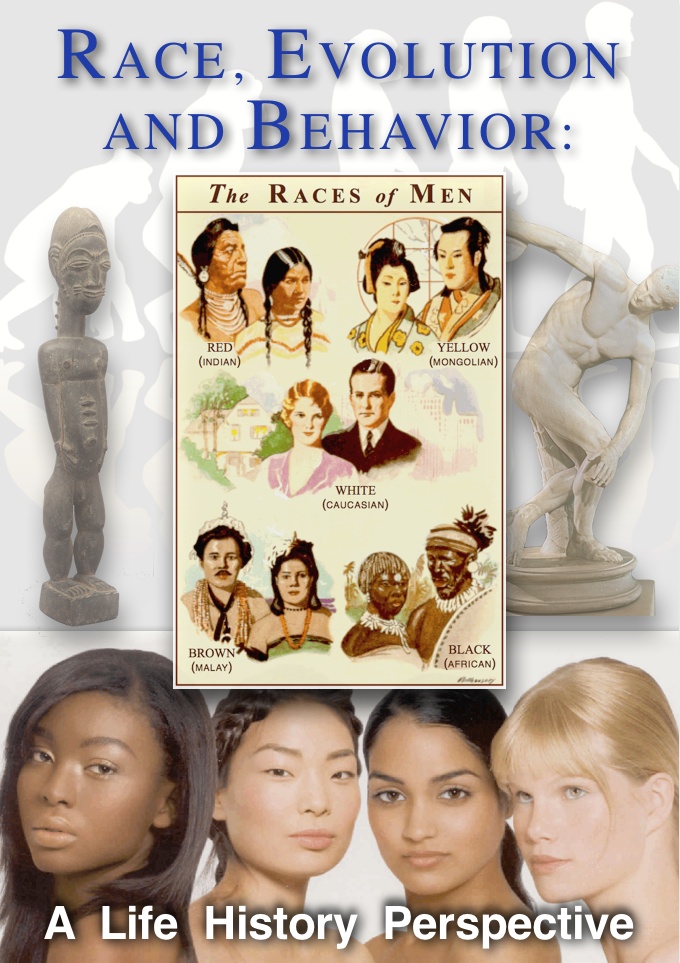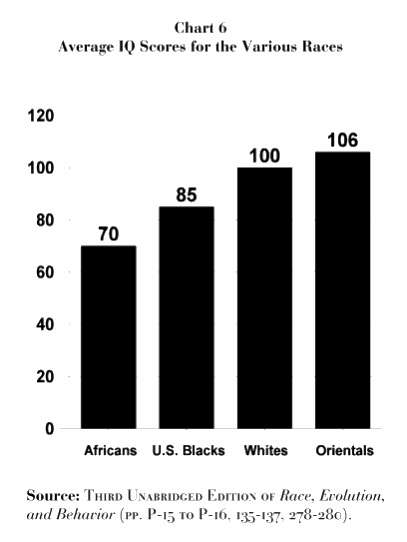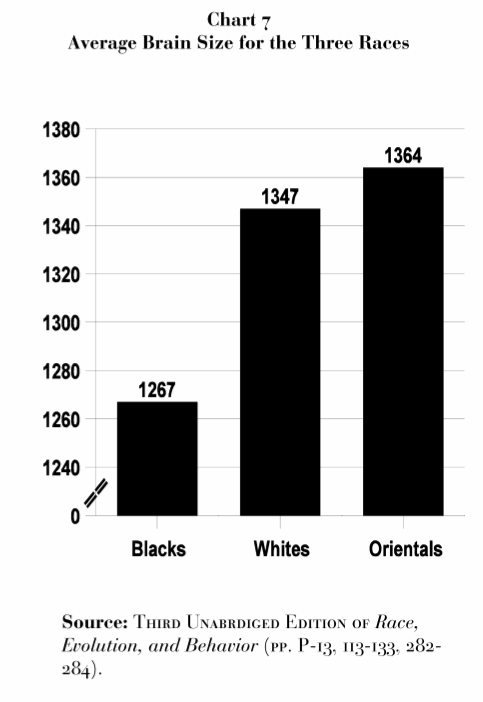RACE, EVOLUTION, AND BEHAVIOR:
A Life History Perspective
[Part 4]
2nd Special Abridged Edition
By Professor J. Philippe Rushton
University of Western Ontario
London, Ontario, Canada N6A 5C2
Author
J. Philippe Rushton is a professor of psychology at the University of Western Ontario, London, Ontario, Canada. Rushton holds two doctorates from the University of London (Ph.D. and D.Sc) and is a Fellow of the John Simon Guggenheim Foundation, the American Association for the Advancement of Science, and the American, British, and Canadian Psychological Associations. He is also a member of the Behavior Genetics Association, the Human Behavior and Evolution Society, and the Society for Neuroscience. Rushton has published six books and nearly 200 articles. In 1992 the Institute for Scientific Information ranked him the 22nd most published psychologist and the 11th most cited. Professor Rushton is listed in Who’s Who in Science and Technology, Who’s Who in International Authors, and Who’s Who in Canada.
[Page 5]
Contents
Preface 6
1. Race is More Than Skin Deep 7
Race in History
Race in Today’s World
Why Are There Race Differences?
Conclusion
Additional Readings
2. Maturation, Crime, and Parenting 13
Maturation
Crime
Personality, Aggression, and Self-Esteem
Parenting and Out-of-Wedlock Births
Longevity and Population Growth
Conclusion
Additional Readings
3. Sex, Hormones, and AIDS 18
Sexual Behavior and Attitudes
Sexual Physiology and Anatomy
AIDS and HIV
Conclusion
Additional Readings
4. Intelligence and Brain Size 22
Culture Fair Tests
Intelligence and Brain Size
Race Differences in Brain Size
Magnetic Resonance Imaging
Brain Weight at Autopsy
Measuring Skull Size
Measuring Living Heads
Summarizing Brain Size Differences
Conclusion
Additional Readings
5. Genes, Environment, or Both? 28
Heritability Studies
Adoption Studies
Race and Heritability
Trans-racial Adoption Studies
Heritabilities Predict Racial Differences
Regression to the Average
Conclusion
Additional Readings
6. Life History Theory 34
r-K Life History Theory
Race Differences and r-K Strategies
Testosterone — The Master Switch?
Conclusion
Additional Readings
7. Out of Africa 39
The Evidence
Geography and Race
Conclusion
Additional Readings
8. Questions and Answers 42
Is Race a Useful Concept? (Chapter 1)
Are the Race Differences Real? (Chapters 2 through 5)
Is the Relationship Between Race and Crime Valid? (Chapter 2)
Is the Relationship Between Race and Reproduction Valid? (Chapter 3)
Is the Genetic Evidence Flawed? (Chapter 5)
Is r-K Theory Correct? (Chapter 6)
Aren’t Environmental Explanations Sufficient? (Chapter 5)
Is Race Science Immoral? (Chapter 1)
Closing Thoughts
Additional Readings
[Page 6]
4: Intelligence and Brain Size
[Page 22]
IQ tests measure intelligence and predict real life success. The races differ in brain size and on IQ tests. On average Orientals have the largest brains and highest IQs. Blacks average the lowest, and Whites fall in between. The brain size differences explain the IQ differences both within groups and between groups.
Psychologists use IQ tests to measure what we call “intelligence” or “mental ability.” Brighter people score higher on IQ tests than most people. Less bright people score lower. IQ tests are not perfect, but they are useful and tell us a lot.
IQ tests are made to have an average of 100. The “normal” range goes from “dull” (IQ around 85) to “bright” (IQ around 115). IQs of 70 suggest handicap, while IQs of 130 and above predict giftedness. The average Oriental IQ is about 106, the White IQ about 100, and the Black IQ about 85. This pattern is found around the world, with Blacks in Africa having a lower IQ than Blacks in America.
The 1994 best seller The Bell Curve shows how IQ predicts success in education, jobs, and training. Low IQ predicts child abuse, crime and delinquency, health, accident proneness, having a child out of wedlock, getting a divorce before five years of marriage, and even smoking during pregnancy. Groups with higher IQs have more gifted people. While Orientals developed complex societies in Asia, and Whites produced complex civilizations in Europe, Black Africans did not.
The Black-White difference in IQ appears as early as three years of age. If the races are matched for education and income, the gap only goes down by 4 IQ points. So, Black-White differences are not due only to social class. It is less well known that Orientals have a higher IQ than Whites.
The Bell Curve highlighted British psychologist Richard Lynn’s 20 year survey of the global pattern of IQ scores. He found Orientals in the Pacific Rim to have IQs in the 101 to 111 range, Whites in Europe to have IQs of 100 to 103, and Blacks in Africa to have IQs of around 70 (see Chart 6).
The average IQ of 70 for Blacks living in Africa is the lowest ever recorded. The Raven’s Progressive Matrices measures reasoning, not culturally specific information. Using this test, Kenneth Owen found a Black African IQ of 70 for 13-year-olds in the South African school system. So did Fred Zindi, a Black Zimbabwean, in a study of 12-to 14-year-olds in his country. Interestingly, the Mixed-Race students in South Africa had an IQ of 85 — the same as Blacks in the United States, Britain, and the Caribbean. Genetic methods (like those used in paternity tests) show that Mixed-Race Blacks have about 25% White ancestry. Their IQs fall half way between pure Blacks (70) and pure Whites (100).
[Page 23]
Culture Fair Tests
Is it fair to compare race and IQ? Yes. First, IQ tests predict achievement in school and on the job just as well for Blacks as for Whites and Orientals. Second, the very same race differences show up on tests made to be “culture-free” as well as on standard IQ tests. In fact, Blacks score slightly higher on standard IQ tests than they do on these “culture-free” tests. This is the opposite of what culture theory predicts.
Blacks score higher on verbal tests than they do on nonverbal tests, and they do better on tests of school knowledge than they do on tests of reasoning ability. From grades 1 to 12, Blacks fall just as far below Whites in school work as they do on IQ tests. Blacks score below even more disadvantaged groups, such as American Indians. Again, this is not what culture theory predicts.
Black-White differences are greatest on tests of reasoning and logic. Blacks do best on tests of simple memory. For example, Blacks do almost as well as Whites on tests of Forward Digit Span, in which people repeat a series of digits in the same order as they have heard them. Blacks do much poorer than Whites, however, on tests of Backward Digit Span, in which people repeat the digits back in reverse order. Hundreds of studies reviewed in Arthur Jensen’s book The g Factor show how hard it is to explain race differences in IQ just in terms of cultural bias.
[Page 24]
Probably reaction time is the simplest culture free mental test. In the “odd-man-out” test, 9- to 12-year-old children look at a set of lights. They have to decide which one goes on, and then press the button closest to that light.
The test is so easy that all children can do it in less than one second. Even here, children with higher IQ scores are faster than lower IQ children. Around the world, Oriental children are faster than White children who are faster than Black children.
Intelligence and Brain Size
My article with C. D. Ankney “Brain Size and Cognitive Ability” in the 1996 issue of the journal Psychonomic Bulletin and Review surveyed all the published research on this topic. It included studies that used the state-of-the-art technique known as Magnetic Resonance Imaging (MRI) which gives a very good image of the human brain. There were eight of these studies with a total sample size of 381 adults. The overall correlation between IQ and brain size measured by MRI is 0.44. This is much higher than the 0.20 correlation found in earlier research using simple head size measures (though 0.20 is still significant). The MRI brain size/IQ correlation of 0.44 is as high as the correlation between social class at birth and adult IQ.
Race Differences in Brain Size
Chart 7 shows that there are race differences in brain size. Orientals average 1 cubic inch more brain matter than Whites, and Whites average a very large 5 cubic inches more than Blacks. Since one cubic inch of brain matter contains millions of brain cells and hundreds of millions of connections, brain size differences help to explain why the races differ in IQ.
[Page 25]
The rest of this chapter documents that four different methods used to measure brain size all produce the same results. The methods are MRI, weighing the brain at autopsy, measuring the volume of an empty skull, and measuring the outside of the head. Note that race differences in brain size remain even after you adjust for body size.
Magnetic Resonance Imaging
One MRI study of race differences in brain size looked at over 100 people in Britain. (It was published in the 1994 issue of Psychological Medicine). The Black Africans and West Indians in the study averaged smaller brains than did the Whites. Unfortunately, the study did not give much information on the age, sex, and body size of the people tested.
Brain Weight at Autopsy
In the 19th century, the famous neurologist Paul Broca found that Orientals had larger and heavier brains than did Whites, while Whites had larger and heavier brains than did Blacks. Broca also found that White brains had more surface folding than Black brains. (The more folded the surface of the brain, the more brain cells it can contain.) White brains also had larger frontal lobes which are used in self control and planning.
By the early 20th century, anatomists had reported brain weights at autopsy in journals such as Science and the American Journal of Physical Anthropology. These early studies found the brain weights of Japanese and Koreans were about the same as those of Europeans, even though the Orientals were shorter in height and lighter in weight.
In 1906, Robert Bean reported on 150 brains of autopsied Blacks and Whites in the American Journal of Anatomy. Brain weight varied with the amount of White ancestry from no White ancestry = 1,157 grams to half-White ancestry = 1,347 grams. He found the brains of Blacks were less folded than those of Whites and had fewer fibers leading to the frontal lobes.
Many other studies followed. In 1934, Vint noted the results of an autopsy study of brain weights from Black Africans in the Journal of Anatomy. He found that the brains of Africans were 10% lighter than those of Whites. In the 1934 issue of Science, Raymond Pearl reviewed autopsy results from Black and White soldiers who had died in the American Civil War (1861-1865). He found the brains of Whites weighed about 100 grams more than the brains of Blacks. And among Blacks, Pearl also found that brain weight increased with the amount of White ancestry.
In a 1970 article in the American Journal of Physical Anthropology, Philip V. Tobias claimed that all these early studies were wrong. He said they ignored factors like “sex, body size, age of death, childhood nutrition, origin of sample, occupation, and cause of death.” However, when I myself averaged all the data in Tobias’s review, I found it still showed that Orientals and Whites have heavier brains than Blacks. Even Tobias finally had to agree that Orientals have “millions” more extra neurons than Whites who have “millions” more than Blacks.
In 1980, Kenneth Ho’s team confirmed the Black-White differences. Their autopsy study was published in the Archives of Pathology and Laboratory Medicine. It avoided the possible errors claimed by Tobias. Original brain weight data for 1,261 American adults showed that Whites averaged 100 grams more brain weight than did Blacks. Because the Blacks in the study were similar in body size to the Whites, differences in body size do not explain away these race differences in brain size.
[Page 26]
Measuring Skull Size
Another way to measure brain size is by filling skulls with packing material. In the 19th century, over 1,000 skulls were studied by American anthropologist Samuel George Morton. He found that Blacks had skulls about 5 cubic inches smaller than Whites.
In 1942, anatomist Katherine Simmons reported on over 2,000 skulls in the journal Human Biology. She confirmed Morton’s earlier work finding that Whites have larger skulls than Blacks. Because the Blacks in her sample were taller than the Whites, the skull size differences could not be due to body size.
Kenneth Beals and his team further confirmed these findings in the 1984 issue of Current Anthropology. They reported the measurements of up to 20,000 skulls from around the world. Skull sizes varied with place of origin. Skulls from East Asia were 3 cubic inches larger than those from Europe which were 5 cubic inches larger than skulls from Africa.
Measuring Living Heads
Brain size can be measured by taking outside head measurements. These results confirm the findings based on the method of weighing brains and filling skulls.
I reported (in the journal Intelligence, 1992) on a sample of thousands of U.S. Army personnel. Even after correcting for body size, Orientals had a larger head size than Whites, who had a larger head size than Blacks (see Chart 2, page 23). In 1994, I reported (also in Intelligence) a study of tens of thousands of men and women collected by the International Labour Office in Geneva, Switzerland. Head sizes (corrected for body size) were larger for East Asians than for Europeans. Europeans had larger heads than Blacks.
In another study (in the 1997 issue of Intelligence), I reported the measurements for 35,000 children followed from birth to age 7 by the famous Collaborative Perinatal Study. At birth, four months, one year, and seven years, Oriental children had larger cranial sizes than White children, who had larger cranial sizes than Black children (see Chart 2, p. 23). These differences were not due to body size because the Black children were taller and heavier than the White and Oriental children.
Summarizing Brain Size Differences
Chart 7 shows average brain size for the three races using all four measurement techniques and also (where possible) correcting for body size. Orientals averaged 1,364 cm 3 , Whites averaged 1,347 cm 3, and Blacks averaged 1,267 cm 3. Naturally the averages vary between samples and the races do overlap. But the results from different methods on different samples show the same average pattern — Orientals > Whites > Blacks.
Conclusion
Studies of race differences in brain size use a number of methods, including MRI. All methods produce the same results. Orientals have the largest brains (on average), Blacks the smallest, and Whites in between. These differences in brain size are not due to body size. Adjusting for body size still results in the same pattern. The three-way pattern is also true for IQ. These race differences in brain size mean that Orientals average about 102 million more brain cells than Whites, and that Whites have about 480 million more than Blacks. These differences in brain size probably explain the racial differences in IQ and cultural achievement.
Additional Readings
Jensen, A. R. (1998). The g Factor. Westport, CT: Praeger.
[Page 27]
Rushton, J. P. & Ankney, C. D. (1996). Brain size and cognitive ability: Correlations with age, sex, social class, and race. Psychonomic Bulletin and Review, 3, 21-36.
Click here for Race, Evolution and Behavior >>>
Part 1: Preface; Race is More Than Skin Deep
Part 2: Maturation, Crime, and Parenting
Part 3: Sex, Hormones, and AIDS
Part 4: Intelligence and Brain Size
Part 5: Genes, Environment, or Both?
PDF of this blog post.
Click to view or download. >> Race, Evolution, and Behavior – Part 4 Ver 2
Version History
Version 3 Jan 14, 2020 — Re-uploaded images and PDF for katana17.com/wp/ version.
Version 2: Aug 13, 2015 — Added Cover page; improved formatting; expanded Contents page; added updated PDF (ver 2).
Version 1: Published Jun 16, 2014





Pingback: RACE, EVOLUTION, AND BEHAVIOR - Part 1: Preface; Race is More Than Skin Deep - katana17katana17